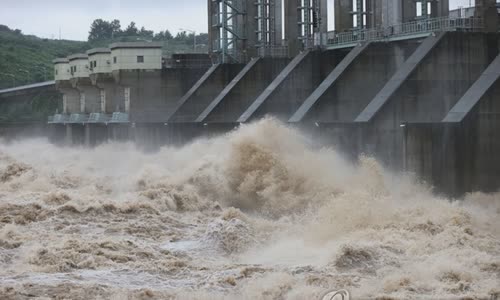South Korea said North Korea remains open to flood discharge of Hwanggang dam near the border and is concerned about the risk of rising water, threatening downstream areas.
"Our assessment is that the flood gates of the Hwanggang dam are still partially open due to heavy rains in North Korea," said Colonel Kim Jun-rak, spokesperson for the Korean Joint Chiefs of Staff (JCS),

Floodwaters were released from Gunnam dam on the Imjin River that flows across the inter-Korean border in the border town of Yeoncheon, north of Seoul, South Korea on August 6 Photo: Yonhap
North Korea has recently been hit hard by downpouring rains in many areas, including the granaries of the south.
Kim said the South Korean military is closely monitoring the situation and sharing information with other government agencies to protect the safety of people and troops nearby.
South Korea closely watched North Korea's dam discharge after Pyongyang's sudden flooding in 2009, causing water levels downstream of the Imjin River to rise, leading to the deaths of six campers.
As of this morning, the water level on the Imjin River has remained stable, according to an official at the Ministry of Unification of Korea.
"As of 10am, the water level at the Pilseung Bridge is 6.3 meters. The water level of the Imjin River has gradually decreased after recording a level of 9.2 meters at about 7 p.m. yesterday," he said.
Last week, North Korea partially opened the floodgate of the Hwanggang Dam on the inter-Korean western border and led water into the Imjin River, a move that has alerted officials to the danger of rising water levels in South Korea.
South Korea recorded a record 49 consecutive rainy days and is expected to continue to continue until the middle of this month, concentrated in Seoul, Gyeonggi Province and western Gangwon Province.



 Mary Dewitt
Mary Dewitt







